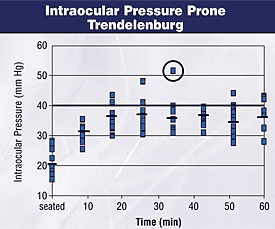Spine surgery position may increase risk for postop vision loss
Intraocular pressure increases when patients are in the prone Trendelenburg position, potentially leading to ischemic optic neuropathy.
CHICAGO – Placing patients in the prone Trendelenburg position during spine surgery may put them at an increased risk for postoperative vision loss.
Previously found to occur in 0.05% to 0.2% of spine surgeries, researchers have attributed postoperative vision loss to increased intraocular pressure (IOP) when a patient is in the prone position, said Kristina Sinacori Walick, MD, of the Brooke Army Medical Center in Ft. Sam Houston, Texas.
“Increased intraocular pressure decreases perfusion into the optic nerve when combined with decreased mean arterial pressure. This may lead to ischemic optic neuropathy,” Walick said at the American Academy of Orthopaedic Surgeons 73rd Annual Meeting. “Ischemic optic neuropathy is the cause of blindness after spine surgery in 90% of the cases.”
Courtesy of Kristina Sinacori Walick |
Walick and her colleagues set out to determine if prone Trendelenburg positioning risks postoperative vision loss more than the typical prone flat position. They recruited 20 young, healthy study volunteers with ages ranging from 20 years to 35 years.
Researchers divided the patients into two groups: Group I patients were placed in the prone flat position and Group II patients were placed in the prone Trendelenburg position with the head tilted 7° below the heart, Walick said.
An ophthalmologist measured IOP changes with a hand-held tonometer when patients were seated, one minute after they were positioned (time 0) and at 10-minute intervals for 60 minutes, Walick said. Researchers found no difference between the two groups in IOP when seated.
However, “The difference between the two groups was statistically significant at every point in time in their test positions,” Walick said. The mean difference at each time point between the two groups was 5.4 mm Hg more in the Group II patients (P=.001).
In both groups, the mean difference in IOP between seated and all other time intervals was statistically significant, Walick said.
Specifically, in Group I patients, mean IOP increased significantly between 0 and 50 minutes (P=.049) and from 0 and 60 minutes (P=.026), Walick said. In Group II patients, mean IOP increased significantly between 0 and 40 minutes (P=.003) and 0 and 60 minutes (P=.029).
In Group II patients, IOP increased significantly by a mean 36.1 mm Hg from the seated position to the prone Trendelenburg position. Also, “Every time period starting at 10 minutes has intraocular pressures greater than 40 mm Hg,” Walick said. “Our highest absolute pressure in the prone Trendelenburg group was 51.5 mm Hg.”
Studies have shown that blood flow to the optic nerve is constant until IOP reaches 40 mm Hg. In Group II patients, researchers measured IOP over 40 mm Hg within 10 minutes, and these pressures continued to rise throughout the hour.
Walick noted that previous studies show induced optic neuropathy when IOP reaches 50 mm Hg for 108 minutes. “In both groups, increased duration of position contributed to a statistically significant increase in intraocular pressure at 60 minutes,” she said.
Courtesy of Kristina Sinacori Walick |
Contributing factors
Of course, other factors to put some spine surgery patients at risk for postoperative vision loss, she said.
“Etiologies are uncertain, but it’s likely a multi-hit phenomenon,” Walick said. “There’s previous built-in factors that make the optic nerve susceptible to ischemia, and there are facilitating factors that act as a final insult for building ischemia of the optic nerve.”
Predisposing factors include neurovascular disease, diabetes and optic nerve blood supply variations. Precipitating factors include deliberate hypotension during surgery, anemia and blood loss, Walick said.
“What’s striking is that our intraocular pressure changes were still so high with such a healthy population, which I think lends to the question — when you are operating on elderly patients who do have some of these risk factors, what are their pressures going to be? Probably very high,” Walick said.
Even predisposing factors in healthy patients can make them less tolerant of increases in IOPs. These factors include optic nerve blood supply variations between an individual’s eyes, watershed areas and abnormal autoregulation, which has been found in 20% of patients, Walick said.
To reduce patients’ risk of postoperative vision loss, spine surgeons can operate with the patients placed in prone flat or a slightly higher position to limit elevations in IOP.
Walick added: “We can monitor time in prone Trendelenburg and return the table to 0° flat as soon as possible if prone Trendelenburg is used. Postoperatively, we need to ask our patients about vision, and if there are any abnormalities, obtain an ophthalmology consultation.”
For more information:
- Walick K, Kragh J, Ward J, et al. Intraocular pressure changes with surgical position: A risk factor for postoperative vision loss. #187. Presented at the American Academy of Orthopaedic Surgeons 73rd Annual Meeting. March 22-26, 2006. Chicago.


